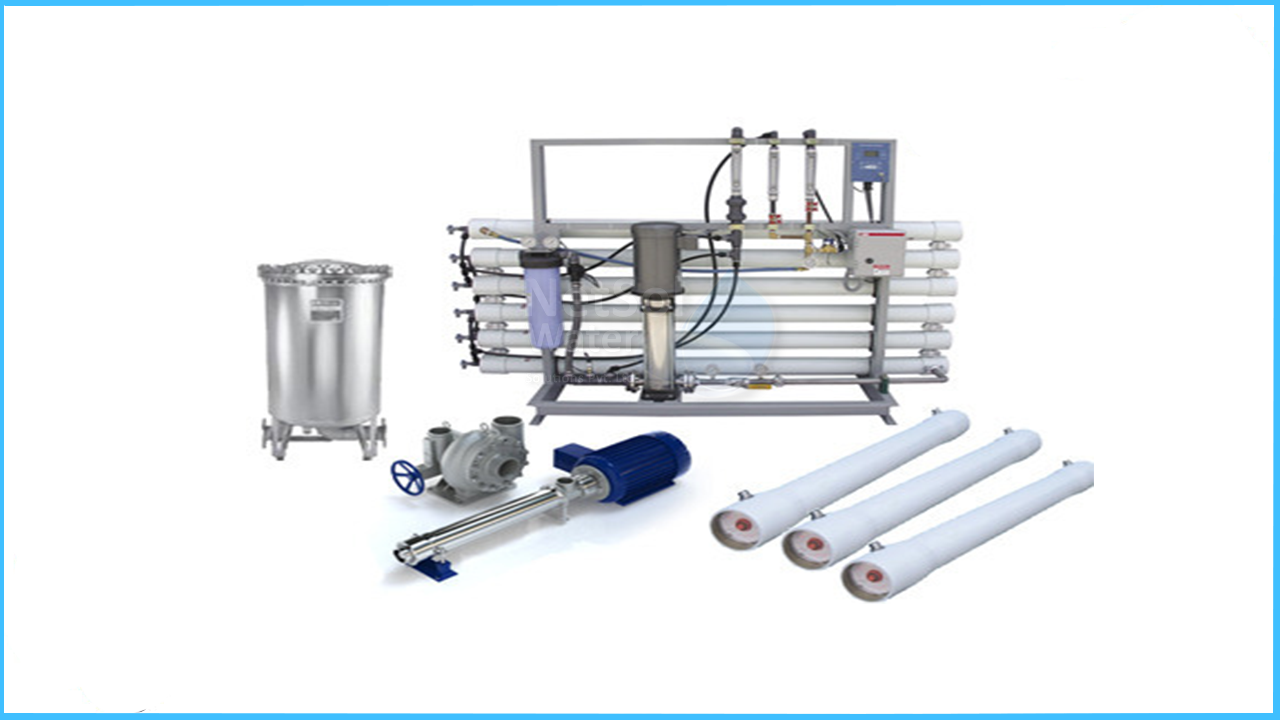Components of RO water plant
As a leading commercial RO plant manufacturer we are using below metioned must use part in every commercial/industrial water treatment systems.
1. WATER SUPPLY CONNECTOR: A water supply connector, also recognized as a feed water supply adapter, connects to the property cold water supply as the reverse osmosis filter's water source. NETSOL RO systems include an adapter for different supply valves. The manufacturer may include a selection of fittings, valves, and saddle valves to best match the plumbing configuration.
2. PRESSURE REGULATOR: To protect the pre-filter housings from high pressure and water hammer, a pressure regulating valve is used. Standard housings typically have a maximum pressure rating of 75 PSI, particularly clear housings made of Styrene Acrylonitrile (SAN) plastic.
 3. SEDIMENT PRE-FILTER: The sediment cartridge filters out sand, grit, precipitated mineral particles, insoluble iron oxide, and other debris that can clog the reverse osmosis membrane surface or plug the drain flow restrictor, resulting in decreased water production. Most NETSOL RO systems employ sediment filters capable of removing particulate matter as small as 5 microns. This filter should be replaced at least every 6 months, according to NETSOL. Every three months, RO sediment filters must be replaced.
3. SEDIMENT PRE-FILTER: The sediment cartridge filters out sand, grit, precipitated mineral particles, insoluble iron oxide, and other debris that can clog the reverse osmosis membrane surface or plug the drain flow restrictor, resulting in decreased water production. Most NETSOL RO systems employ sediment filters capable of removing particulate matter as small as 5 microns. This filter should be replaced at least every 6 months, according to NETSOL. Every three months, RO sediment filters must be replaced.
4. CARBON FILTER FOR CHLORINE REMOVAL: City utilities disinfect drinking water to prevent the growth of harmful bacteria, viruses, and other microorganisms that can cause serious illness and/or death. These chlorinated water supplies, on the other hand, can deteriorate TFC membranes over time. Most city water utilities require that water leaving the plant with a minimum chlorine level of 1.0 mg/L. (1.0 ppm). After 1000 ppm-hours of free chlorine exposure, the RO membranes may allow for increased TDS passage (less contaminant rejection). The carbon filter removes chlorine and protects the membrane downstream of it.
5. CARBON FILTER FOR CHLORAMINE REMOVAL: Water systems such as the Los Angeles Department of Water and Power (LADWP) have recently begun to disinfect water with chloramine. The new standard was established by the United States Environmental Protection Agency and the State as a result of numerous studies linking chlorine disinfection byproducts to an increased risk of cancer. Reverse Osmosis membranes can withstand higher concentrations of chloramines (1 to 2 ppm) than chlorine (0.1 ppm) before damage occurs, resulting in lower salt rejection. Metals in water, such as iron or aluminum, can act as catalysts, accelerating membrane oxidation even at low chloramine concentrations. Activated carbon is also effective once more against chloramine.
 6. AUTO SHUT-OFF VALVE: Saves water by turning off the drain flow when the tank is full. The ASO valve's primary function is to control the water supply to the reverse osmosis membrane. When the pressurized storage tank reaches two-thirds of the feed pressure, the ASO valve shuts off the water supply to the membrane and waits until the tank is drained to one-third of the feed pressure before resuming water supply.
6. AUTO SHUT-OFF VALVE: Saves water by turning off the drain flow when the tank is full. The ASO valve's primary function is to control the water supply to the reverse osmosis membrane. When the pressurized storage tank reaches two-thirds of the feed pressure, the ASO valve shuts off the water supply to the membrane and waits until the tank is drained to one-third of the feed pressure before resuming water supply.
7. REVERSE OSMOSIS MEMBRANE: The RO membrane does the majority of the heavy lifting in the system. It removes more than 96 % dissolved solids (salts, minerals, and metals), microorganisms, and organic substances from water. The membrane separates the flow of water into two streams. The membrane's filtered water is routed to the storage tank. Water that is rejected is drained. Most standard RO systems produce approximately 4 gallons of waste water per 1 gallon purified (4:1) if the customer is on a city water supply with a water pressure greater than 70 PSI. The flow restrictor on the drain line controls this ratio.
8. CHECK VALVE: When the ASO valve turns off the feed water pressure to the membrane, the check valve prevents pressurized filtered water in the storage tank from flowing back and rupturingthe RO membrane. In our systems, a check valve is installed immediately after the membrane on the permeate (filtered water) line.
9. PRESURRIZED WATER STORAGE TANK:When the drinking water faucet is turned on, the pressure tank in a RO system store filtered water from the membrane permeate and provides water under pressure. A water chamber is separated from compressed air by a bladder contained within a metal or plastic case. When the tank is filled with RO water, the bladder expands and compresses the air inside the casing even more.
10. DRINKING WATER FAUCET: Often these RO systems include drinking water faucets that do not have an air gap and simply dispense purified water. Some air gap faucets that come with RO systems also have drain line connections on them, which protect the RO in the event of reverse suction through the system.



